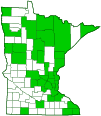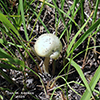Eastern North American Destroying Angel
(Amanita bisporigera)
Conservation • Description • Habitat • Ecology • Distribution • Taxonomy
Conservation Status |
|||
| IUCN Red List | not listed |
||
| NatureServe | NNR - Unranked |
||
| Minnesota | not listed |
||
Description
Eastern North American Destroying Angel is a common, medium-sized, deadly poisonous, gilled mushroom. As the common name implies, it occurs in eastern North America, specifically in the United States east of the Great Plains, in adjacent Canadian provinces, and in Mexico and Central America. It is the most common “destroying angel” in the eastern United States and Canada.
Eastern North American Destroying Angel is found in deciduous and mixed woodlands in the summer and fall, alone, scattered, or in groups. It grows on the ground near oak trees and possibly other hardwoods. It is mycorrhizal, obtaining its nutrients from the rootlets of a tree while facilitating greater absorption of nutrients from the soil by the tree.
Eastern North American Destroying Angel is a tall white mushroom on a slender stalk. The cap on young mushrooms is oval or nearly round at first, becoming broadly convex then ultimately nearly flat at maturity. The mature cap is is 1″ to 4″ in diameter. The upper surface is hairless and usually dry to the touch, sticky when moist. It is white, rarely becoming yellowish or pinkish, and sometimes darkening in the center with age. There are no patches or warts on the surface. The margin is not lined with grooves (striated) and does not have remnants of the universal veil.
The stalk is solid, 23⁄16″ to 5½″ (5.5 to 14 cm) tall, and 3⁄16″ to ¾″ (5 to 20 mm) thick. It tapers slightly to the top and has an expanded, cup-like base (volva) up to 1½″ in height. The volva is a remnant of a protective, egg-like covering (universal veil) that completely envelopes the developing mushroom when young. It may be partially or completely buried in the ground. The volva sometimes breaks up as the stalk expands. Near the top of the stalk, below the cap and gills, is a membranous ring. This is the remnant of a protective covering (partial veil) of the developing gills.
The gills are white, closely spaced or crowded, and free, not attached to the stalk. Between adjacent gills there is frequently another short gill.
The flesh is white and deadly poisonous, not edible. Young mushrooms have no odor. Older mushrooms have a sickly sweet smell like rotting meat.
The spore print is white.
Similar Species
Habitat and Hosts
On the ground near oak trees
Ecology
Season
Summer and fall
Distribution |
||
|
Sources Biodiversity occurrence data published by: Minnesota Biodiversity Atlas (accessed through the Minnesota Biodiversity Atlas Portal, bellatlas.umn.edu, 10/1/2025). |
|
| 10/1/2025 | ||
Occurrence |
||
Widely distributed and common |
||
Taxonomy
Kingdom
Fungi (Fungi)
Subkingdom
Dikarya
Phylum
Basidiomycota (Basidiomycete Fungi)
Subphylum
Agaricomycotina (Higher Basidiomycetes)
Class
Agaricomycetes (Mushrooms, Bracket Fungi, Puffballs, and Allies)
Subclass
Agaricomycetidae
Order
Agaricales (Common Gilled Mushrooms and Allies)
Suborder
Pluteineae
Family
Amanitaceae (Amanita mushrooms and allies)
Tribe
Amaniteae
Genus
Amanita (Amanita mushrooms)
Subgenus
Amanitina
Section
Phalloideae
Subordinate Taxa
Synonyms
Amanitina bisporigera
Common Names
Destroying Angel
Eastern North American Destroying Angel
North American Destroying Angel
North American Two-spored Destroying Angel
Glossary
Mycorrhizal
A symbiotic, usually beneficial relationship between a fungus and the tiny rootlets of a plant, usually a tree.
Partial veil
A protective covering over the gills or pores of a developing mushroom. At maturity it disappears, collapses into a ring around the stalk, or wears away into a cobwebby covering and ring zone.
Striate
Striped or grooved in parallel lines (striae).
Universal veil
An egg-like structure that envelopes all or most of a developing gill mushroom. Remnants of the universal veil sometimes visible on a mature mushroom are patchy warts on the cap, a ring on the stalk, and a volva at the base of the stalk.
Volva
Also called cup. A cup-like covering at the base of a mushroom stem, sometimes buried. In Amanita, Volvariella, and some other mushrooms, it is the remnants of the universal veil ruptured by the mushroom pushing through. In Phallales it is the remnants of the ruptured peridium.
Visitor Photos
Share your photo of this fungus.
This button not working for you?
Simply email us at info@MinnesotaSeasons.com.
Attach one or more photos and, if you like, a caption.
Dan W. Andree |
||
Some kind of small whitish mushroom.... It was partway up from a low area between two hills. |
||
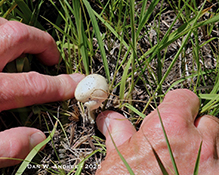 |
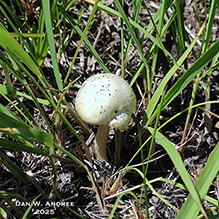 |
|
AGShep |
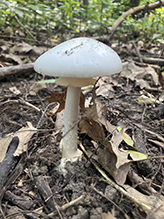 |
FMF CHOP |
||
White spore print. Found in grass near dying maple. |
||
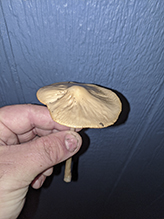 |
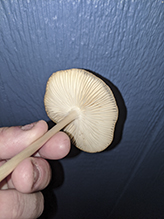 |
|
Jeffrey M. Arsenault |
||
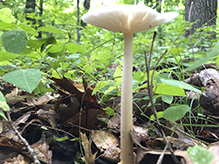 |
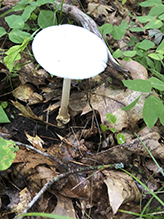 |
|
MinnesotaSeasons.com Photos
|

Slideshows

Visitor Videos
Share your video of this fungus.
This button not working for you?
Simply email us at info@MinnesotaSeasons.com.
Attach a video, a YouTube link, or a cloud storage link.
Other Videos
One Poisonous Mushroom | One Poisonous Plant
Learn Your Land
What's That Fungus? - Amanita bisporigera
KY Forest Health
ID destroying angel mushrooms, Amanita bisporigera and allies
Anna McHugh
Rhode Island Amanita Series: Amanita bisporigera
Spike M

Visitor Sightings
Report a sighting of this fungus.
This button not working for you?
Simply email us at info@MinnesotaSeasons.com.
Be sure to include a location.
Dan W. Andree
7/1/2025
Location: Frenchman’s Bluff SNA
Some kind of small whitish mushroom....
It was partway up from a low area between two hills.
MinnesotaSeasons.com Sightings |
|

